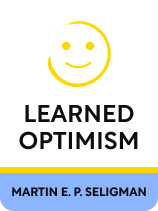

This article is an excerpt from the Shortform book guide to "Learned Optimism" by Martin E. P. Seligman. Shortform has the world's best summaries and analyses of books you should be reading.
Like this article? Sign up for a free trial here.
What is Martin Seligman’s Learned Optimism book about? What are the most important takeaways from the book?
Martin Seligman wrote Learned Optimism after extensively studying what causes people to feel powerless in life. The book primarily teaches readers why pessimism can lead to mental health problems and how to escape a pessimistic mindset.
Read on for a brief overview of Martin Seligman’s book Learned Optimism, including the key takeaways.
Background: Martin Seligman’s Learned Optimism
Many people suffer from learned helplessness: the belief that they don’t have the power to make positive changes in their own lives or in the world around them. Martin Seligman’s Learned Optimism book will teach you how to break out of that pessimistic, powerless mindset and replace it with an empowered mindset of optimism and confidence.
Seligman is a professional psychologist, teacher, and author. His theories of learned helplessness and learned optimism are based on his own laboratory studies. He began these studies in the 1960s and has continued tweaking and reexamining them to the present day.
The theory of learned helplessness has become widespread, both in the field of psychology and among laypeople. However, Martin Seligman’s Learned Optimism book was published in 1990, and there have been significant advances in the field of psychology since then.
What Is Learned Helplessness?
In psychology, learned helplessness is the belief that you can’t change things and that your efforts won’t make a difference. It’s called learned helplessness because it comes from experience: You go through important situations in which you can’t change the outcome, so you come to believe that you can’t affect the outcome of any important situation.
Seligman adds that many people learn helplessness as children, especially from their parents and teachers. Every time an adult dismisses a child’s contributions and ignores his or her efforts, it ingrains helplessness into that child’s psyche.
Disputing Your Pessimistic Beliefs
In Learned Optimism, Martin Seligman offers a couple of techniques, drawn from cognitive therapy, to help you become more optimistic by changing the way you explain negative events to yourself.
The first technique is to examine your belief. Start this process by asking yourself if what you believe is really true. What evidence is there for it and against it? After considering that evidence, does your belief seem rational? Also, ask what the implications of your belief are. In other words, if it were true, what would that mean for you? Conversely, what would it mean for you if you were wrong? Once you’ve considered whether your belief is true or not, and what that means for you, think about if your belief is useful. Does it empower you, energize you, or help you prepare for the future? If not, is it worth holding on to this belief? On that note, think about some different beliefs you could replace it with. How else might you interpret the event in question? Is there an explanation that doesn’t depend on something being wrong with you?
The second technique is to give pessimistic beliefs an external voice. Find a friend who’s willing to roleplay your negative beliefs. Have that person attack you the same way you attack yourself, and learn to defend yourself from that sort of aggression. You may find it easier to fight back against an external voice, and having to defend yourself out loud might help you to hear how fair and reasonable those defenses really sound.
Balancing Optimism and Realism
According to Martin Seligman’s Learned Optimism, a pessimistic mindset does have one advantage over an optimistic one: Pessimists tend to assess their situations more realistically. Therefore, Seligman concludes by saying that we should balance our optimism with realism, a mindset he calls flexible optimism. The good news is that, because we’ve learned optimism as a skill set—instead of having it as a natural state of mind—we can choose when to apply those skills. For example, if someone is upset with us, we can start by asking ourselves if we’re really to blame (rather than the pessimistic approach of assuming that we are at fault, or the optimistic approach of assuming that we aren’t). With that realistic approach we’ll be able to take appropriate action to fix the situation; even if we decide that all we can do is apologize.

———End of Preview———
Like what you just read? Read the rest of the world's best book summary and analysis of Martin E. P. Seligman's "Learned Optimism" at Shortform.
Here's what you'll find in our full Learned Optimism summary:
- How to break out of a pessimistic, powerless mindset
- How to develop a mindset of empowerment, optimism, and confidence
- How to balance your optimism with realism






